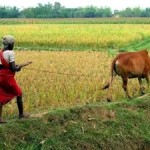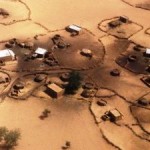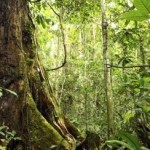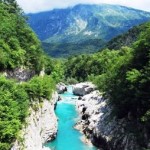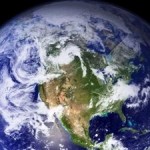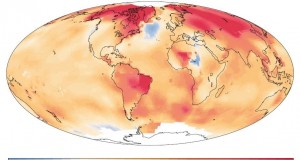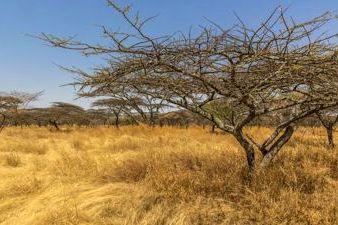
Both freshwater availability for many millions of people and the stability of ecosystems such as the Siberian tundra or Indian grasslands are put at risk by climate change. Even if global warming is limited to 2 degrees above pre-industrial levels, 500 million people could be subject to increased water scarcity – while this number would grow by a further 50 percent if greenhouse gas emissions are not cut soon. At 5 degrees global warming, almost all ice-free land might be affected by ecosystem change. This is shown by complementary studies now published by scientists of the Potsdam Institute for Climate Impact Research (PIK).
“We managed to quantify a number of crucial impacts of climate change on the global land area,” says Dieter Gerten, lead-author of one of the studies. Mean global warming of 2 degrees, the target set by the international community, is projected to expose an additional 8 percent of humankind to new or increased water scarcity. 3.5 degrees – likely to occur if national emissions reductions remain at currently pledged levels – would affect 11 percent of the world population. 5 degrees could raise this even further to 13 percent.
“If population growth continues, by the end of our century under a business-as-usual scenario, these figures would equate to well over one billion lives touched,” Gerten points out. “And this is on top of the more than one billion people already living in water-scarce regions today.” Parts of Asia and North Africa, the Mediterranean and the Middle East are particularly vulnerable.
Even Greater Changes Ahead for the Green Cover of Our Planet
For the green cover of our planet, even greater changes are in store. “The area at risk of ecosystem transformation is expected to double between global warming of about 3 and 4 degrees,” says Lila Warszawski, lead author of another study that systematically compared different impact models – and the associated uncertainties – in order to gain a fuller picture of the possible consequences of climate change for natural ecosystems. This is part of the international Inter-Sectoral Impact Model Intercomparison Project (ISI-MIP).
A warming of 5 degrees, likely to happen in the next century if climate change goes on unabated, would put nearly all terrestrial natural ecosystems at risk of severe change. “So despite the uncertainties, the findings clearly demonstrate that there is a large difference in the risk of global ecosystem change under a scenario of no climate change mitigation compared to one of ambitious mitigation,” says Sebastian Ostberg, lead author of the third study.
The regions at risk under unabated global warming include the grasslands of Eastern India, shrublands of the Tibetan Plateau, the forests of Northern Canada, the savannas of Ethiopia and Somalia, and the Amazonian rainforest. Many of these are regions of rich and unique biodiversity.
The combined changes to both water availability and ecosystems turn out to be non-linear. “Our findings support the assertion that we are fundamentally destabilizing our natural systems – we are leaving the world as we know it,” says Wolfgang Lucht, one of the authors and co-chair of PIK’s Research Domain of Earth System Analysis.
“This is Not About Ducks and Daisies, But the Very Basis of Life”
The studies use a novel methodological approach, introducing new measures of risk based on changes of vegetation structure and flows and stores of carbon and water. To this end, biosphere simulation models were used to compare hundreds of climate change scenarios and highlight which regions may first face critical impacts of climate change.
“The increase in water scarcity that we found will impact on the livelihoods of a huge number of people, with the global poor being the most vulnerable,” says Hans Joachim Schellnhuber, one of the co-authors and director of PIK. This might get buffered to some extent through adaptation measures such as expanding of irrigated cropland. However, such an expansion would further increase the pressure on Earth’s ecosystems and water resources. “Now this is not a question of ducks and daisies, but of our unique natural heritage, the very basis of life. Therefore, greenhouse gas emissions have to be reduced substantially, and soon.”
Article: Gerten, D., Lucht, W., Ostberg, S., Heinke, J., Kowarsch, M., Kreft, H., Kundzewicz, Z.W., Rastgooy, J., Warren, R., Schellnhuber, H.J. (2013): Asynchronous exposure to global warming: freshwater resources and terrestrial ecosystems. Environmental Research Letters, 8 [doi:10.1088/1748-9326/8/3/034032]
URL: http://iopscience.iop.org/1748-9326/8/3/034032/article
Article: Ostberg, S., Lucht, W., Schaphoff, S., Gerten, D. (2013): Critical impacts of global warming on land ecosystems. Earth System Dynamics, 4, 541-565, [doi:10.5194/esdd-4-541-2013]
URL: http://www.earth-syst-dynam.net/4/347/2013/esd-4-347-2013.html
Article: Warszawski, L., Friend, A., Ostberg, S., Frieler, K., Lucht, W., Schaphoff, S., Beerling, D., Cadule, P., Ciais, P., Clark, D.B., Kahana, R., Ito, A., Keribin, R., Kleidon, A., Lomas, M., Nishina, K., Pavlick, R., Rademacher, T.T., Piontek, F., Schewe, J., Serdeczny, O., Buechner, M., Schellnhuber, H.J. (2013): A multi-model analysis of risk of ecosystem shifts under climate change. In: Environmental Research Letters (accepted)
Source: PIK.


